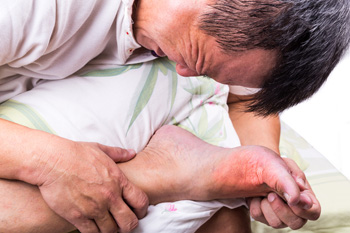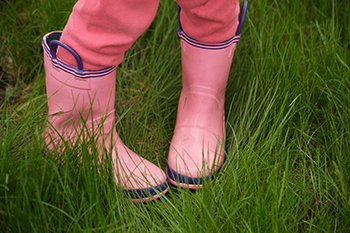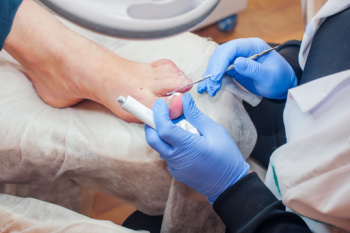
Gout, once known as a disease of indulgence, is becoming increasingly common as rates of obesity and high blood pressure climb. This painful condition occurs when uric acid builds up in the bloodstream, forming sharp crystals that settle in joints, most often the big toe. Sudden swelling, redness, and intense pain can make even a bed sheet feel unbearable. Excess weight and certain medications used for hypertension can raise uric acid levels, triggering more frequent attacks. A podiatrist can help identify gout through diagnostic testing, relieve pain during flare-ups, and create a personalized plan to prevent future episodes. This may include shoe recommendations, dietary guidance, and custom orthotics to ease pressure on sensitive joints. If you experience recurring pain in your toe or foot, it is suggested that you schedule a visit with a podiatrist for evaluation and management.
Gout is a painful condition that can be treated. If you are seeking treatment, contact Barbara J. Aung, DPM from Aung Foot Health Clinic . Our doctor will treat your foot and ankle needs.
What Is Gout?
Gout is a form of arthritis that is characterized by sudden, severe attacks of pain, redness, and tenderness in the joints. The condition usually affects the joint at the base of the big toe. A gout attack can occur at any random time, such as the middle of the night while you are asleep.
Symptoms
- Intense Joint Pain - Usually around the large joint of your big toe, and it most severe within the first four to twelve hours
- Lingering Discomfort - Joint discomfort may last from a few days to a few weeks
- Inflammation and Redness -Affected joints may become swollen, tender, warm and red
- Limited Range of Motion - May experience a decrease in joint mobility
Risk Factors
- Genetics - If family members have gout, you’re more likely to have it
- Medications - Diuretic medications can raise uric acid levels
- Gender/Age - Gout is more common in men until the age of 60. It is believed that estrogen protects women until that point
- Diet - Eating red meat and shellfish increases your risk
- Alcohol - Having more than two alcoholic drinks per day increases your risk
- Obesity - Obese people are at a higher risk for gout
Prior to visiting your podiatrist to receive treatment for gout, there are a few things you should do beforehand. If you have gout you should write down your symptoms--including when they started and how often you experience them, important medical information you may have, and any questions you may have. Writing down these three things will help your podiatrist in assessing your specific situation so that he or she may provide the best route of treatment for you.
If you have any questions, please feel free to contact our office located in Tuscon, AZ . We offer the newest diagnostic and treatment technologies for all your foot care needs.

As children grow, their feet and legs constantly change, sometimes leading to alignment problems such as inward or outward turning or flattened arches. These issues can result from differences in bone growth, muscle tightness, or ligament flexibility. Most mild cases improve with age, but some may cause pain, uneven gait, or frequent tripping, if not corrected. A podiatrist can determine whether the condition is part of normal development or needs treatment. Wearing supportive shoes, gentle stretching, and specially designed orthotics can help realign the feet and encourage healthy movement. In certain situations, targeted exercises or braces may be used to guide proper positioning as a child continues to grow. If you notice your child walking unevenly, stumbling often, or showing signs of discomfort, it is suggested that you have their feet evaluated by a podiatrist to ensure healthy development and alignment.
Making sure that your children maintain good foot health is very important as they grow. If you have any questions, contact Barbara J. Aung, DPM of Aung Foot Health Clinic . Our doctor can provide the care you need to keep you pain-free and on your feet.
Keeping Children's Feet Healthy
Having healthy feet during childhood can help prevent medical problems later in life, namely in the back and legs. As children grow, their feet require different types of care. Here are some things to consider...
Although babies do not walk yet, it is still very important to take care of their feet.
Avoid putting tight shoes or socks on his or her feet.
Allow the baby to stretch and kick his or her feet to feel comfortable.
As a toddler, kids are now on the move and begin to develop differently. At this age, toddlers are getting a feel for walking, so don’t be alarmed if your toddler is unsteady or ‘walks funny’.
As your child gets older, it is important to teach them how to take care of their feet.
Show them proper hygiene to prevent infections such as fungus.
Be watchful for any pain or injury.
Have all injuries checked by a doctor as soon as possible.
Comfortable, protective shoes should always be worn, especially at play.
If you have any questions, please feel free to contact our office located in Tuscon, AZ . We offer the newest diagnostic and treatment technologies for all your foot care needs.

Toenail fungus often begins quietly, with nails that lose their shine and become thick, brittle, or yellowed. As the infection progresses, the nail may separate from the bed, crumble, or develop an uneven surface that makes shoes uncomfortable. If ignored, the infection can damage the nail completely and spread to nearby nails or skin. In some cases, the skin beside the nail becomes sore, swollen, or filled with fluid due to a bacterial infection. Because these changes rarely improve without medical attention, prompt evaluation is important. A podiatrist can determine the cause, remove infected tissue, and prescribe targeted antifungal or antibacterial treatments to restore healthy growth. Addressing nail problems early prevents more serious complications. If your toenails look discolored, thickened, or painful, it is suggested that you schedule an appointment with a podiatrist for a diagnosis and professional care.
If left untreated, toenail fungus may spread to other toenails, skin, or even fingernails. If you suspect you have toenail fungus it is important to seek treatment right away. For more information about treatment, contact Barbara J. Aung, DPM of Aung Foot Health Clinic . Our doctor can provide the care you need to keep you pain-free and on your feet.
Symptoms
- Warped or oddly shaped nails
- Yellowish nails
- Loose/separated nail
- Buildup of bits and pieces of nail fragments under the nail
- Brittle, broken, thickened nail
Treatment
If self-care strategies and over-the-counter medications does not help your fungus, your podiatrist may give you a prescription drug instead. Even if you find relief from your toenail fungus symptoms, you may experience a repeat infection in the future.
Prevention
In order to prevent getting toenail fungus in the future, you should always make sure to wash your feet with soap and water. After washing, it is important to dry your feet thoroughly especially in between the toes. When trimming your toenails, be sure to trim straight across instead of in a rounded shape. It is crucial not to cover up discolored nails with nail polish because that will prevent your nail from being able to “breathe”.
In some cases, surgical procedure may be needed to remove the toenail fungus. Consult with your podiatrist about the best treatment options for your case of toenail fungus.
If you have any questions please contact our office located in Tuscon, AZ . We offer the newest diagnostic and treatment technologies for all your foot and ankle needs.






